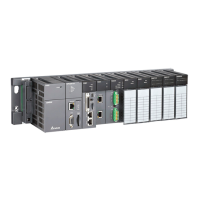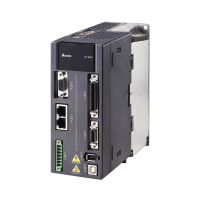Chapter 2 Devices
2-83
latter adopts the decimal system. For example, December is represented as 12 in SR392
while it is represented as 12 in the binary-coded decimal.
Please refer to section 6.17 for more information related to the real-time clock.
4. The functions related to communication
SM96~SM107, SM209~SM212, SR201~SR202, and SR209~SR216
SR215 and SR216 are used to record the interface code of the communication port on the
PLC. The functions represented by the interface codes are as follows.
When the interface of the communication port on the PLC is RS-485, RS-232, or RS-422,
SR209 records the communication format of COM1 on the PLC, and SR212 records the
communication format of COM2 on the PLC. The setting values of the communication
protocols are shown in the following table. Please refer to section 6.19 for more information
related to the communication instructions.
b1
b2
Parity bits
b5
b6
b7
0111 (16#7) :
230400
RS-232 does not
support the baud rate.
1000 (16#8) :
460800
support the baud rate.
1001 (16#9) :
921600
RS-232 does not
support the baud rate.
5. Clearing the contents of the device
SM204/SM205
SM204
All non-latched areas are
cleared.
The non-latched areas in the input relays, the output relays, the
stepping relays, the auxiliary relays, and the link registers are
cleared.
The non-latched areas in the timers, the counters, and the
32-bit counters are cleared.
The non-latched areas in the data registers and the index
registers are cleared.
It takes 530 milliseconds to clear the device. The watchdog
timer does not act during this period of time.
SM205
All latched areas are
cleared.
The latched areas in the timers, counters, and 32-bit counters
are cleared.
The latched auxiliary relays are cleared.
The latched data registers are cleared.
It takes 30 milliseconds to clear the device. T
he watchdog timer
does not act during this period of time.
Please refer to section 2.1.4 for more information related to the latched areas in the device
range.
6. The error log in the PLC

